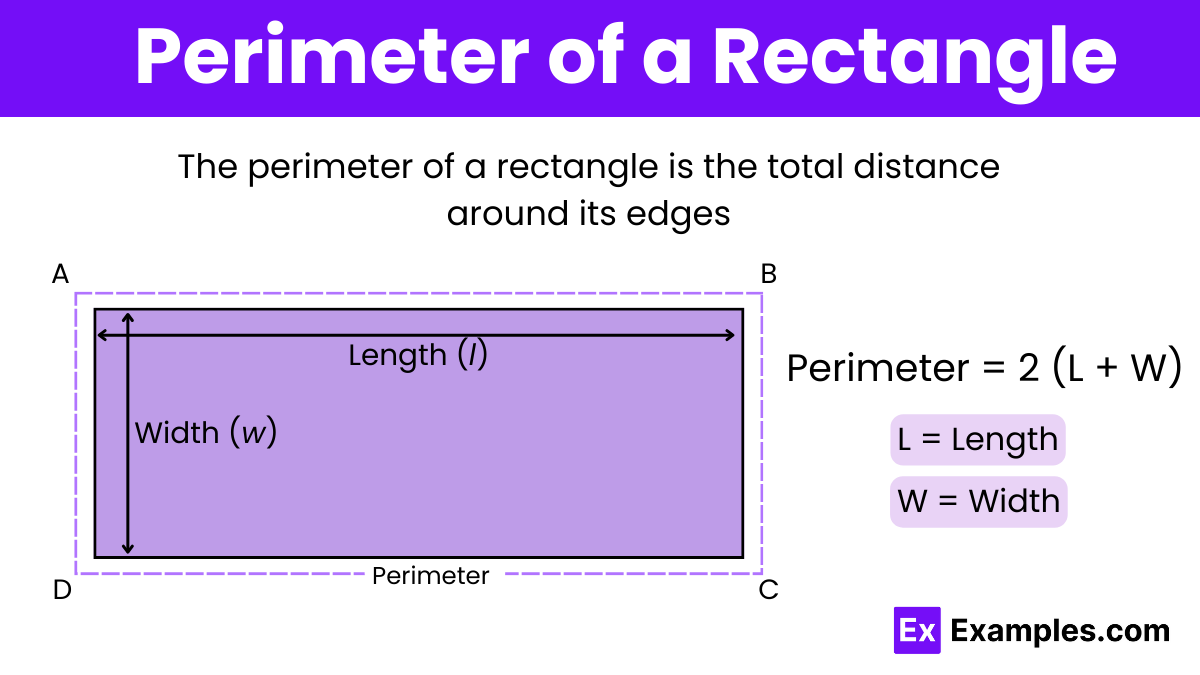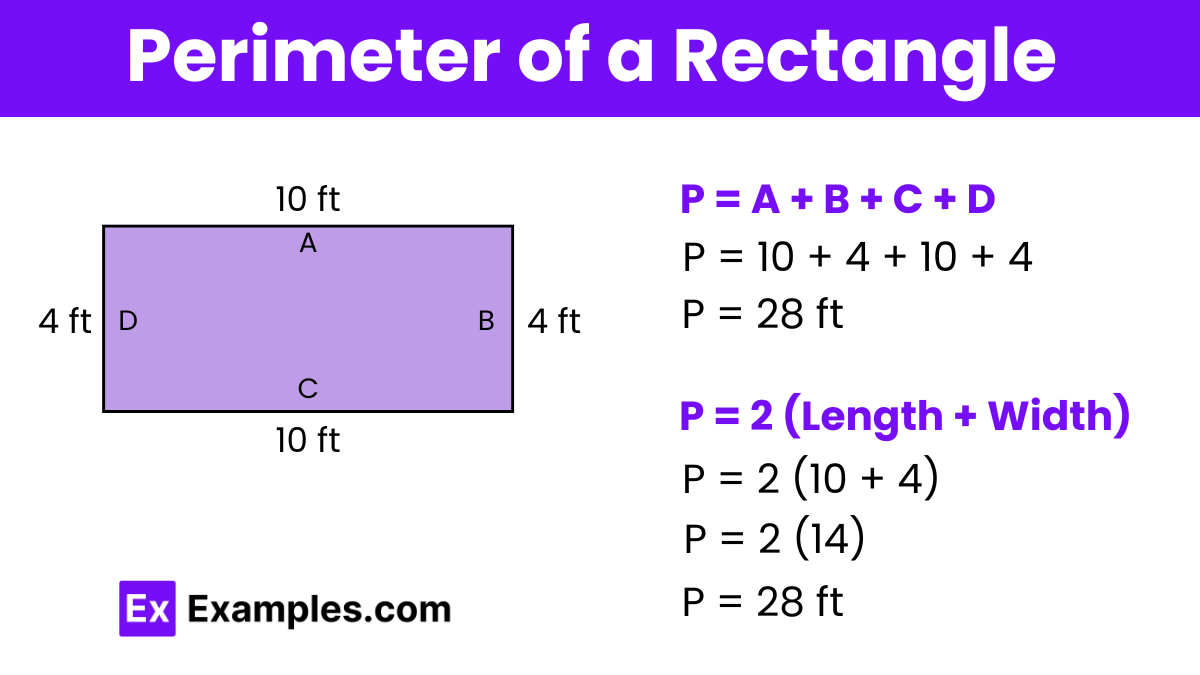If the length of a rectangle is 12 cm and the width is 8 cm, what is the perimeter of the rectangle?
40 cm
48 cm
20 cm
32 cm


The perimeter of a shape is the total distance around its edge. To calculate the perimeter of a rectangle, we add up the lengths of all its sides. However, because each pair of opposite sides in a rectangle is equal, we just need to know the rectangle’s length and width. The formula for the perimeter of a rectangle is to multiply the sum of the length and width by two. Perimeter is measured in units like meters, centimeters, inches, or feet.
To calculate the perimeter of a rectangle, you can use a simple mathematical formula. The formula is based on the properties of a rectangle, where opposite sides are equal in length. Here is how you determine the perimeter:
This formula means that you first add the length and the width of the rectangle. After getting the total of these two dimensions, you multiply the result by two. This calculation gives you the total distance around the rectangle.
Suppose a rectangle has a length of 10 feet and a width of 4 feet. Here’s how you would calculate the perimeter:
So, the perimeter of this rectangle is 28 feet. This calculation is useful for various practical applications, such as figuring out the amount of material needed for a border or fence around the rectangle.

Problem: A rectangle has a length of 6 meters and a width of 2 meters. What is the perimeter?
Solution:
Problem: You need to install a fence around a rectangular garden that measures 15 feet in length and 10 feet in width. How much fencing material will you need?
Solution:
Problem: A rectangular picture measures 8 inches by 5 inches. How much framing material is needed to frame the picture?
Solution:
Problem: A teacher wants to put a decorative border around a rectangular bulletin board that is 12 feet long and 7 feet wide. Calculate the amount of border required.
Solution:
In construction, knowing the perimeter of rectangular areas like rooms, gardens, or plots of land helps in estimating the amount of materials needed. For example, builders calculate the perimeter to determine the length of fencing required, or the amount of baseboard needed to cover the edges of a room.
In crafting, especially when creating frames, the perimeter measurement helps in cutting the right amount of framing material to ensure each side is covered perfectly. Whether it’s a picture frame or a crafted box, the perimeter tells you exactly how much material you’ll need around the edges.
In the manufacturing sector, knowing the perimeter of items can be crucial for fabricating everything from the material needed for the edges of a rectangular metal plate to the trim around textile pieces. This helps in minimizing waste and optimizing the use of materials.
Interior designers use the perimeter of floors and walls to calculate the quantities of materials needed for projects. This could include the amount of paint required to cover the borders of a room, or the length of decorative trim or crown molding.
Farmers and landscapers often calculate the perimeter of rectangular fields and plots to figure out the quantities of materials needed for tasks like installing irrigation systems, fencing, and pathways. Knowing the perimeter helps in budgeting and resource allocation.
In educational settings, teachers use the concept of perimeter to help students understand geometry, measurement, and arithmetic operations. It serves as a practical example to illustrate the application of mathematical concepts in real life.
Calculating the perimeter of rectangular sports fields, such as soccer fields or tennis courts, helps in planning the layout and ensuring the correct dimensions for boundary lines or nets.
The area and perimeter of a rectangle are related through the rectangle’s length and width, but they do not directly influence each other. Changing one dimension affects both the area and the perimeter, but the extent of their change depends on how the dimensions are altered. Here are a few key insights:
Consider two rectangles:
Both rectangles have the same perimeter:
However, their areas are different:
FAQs
To find the perimeter of a rectangle, add the lengths of all four sides: formula is 2×(length+width).
An example of a perimeter is measuring the total length around a garden to determine how much fencing is needed.
Explain perimeter to a child as the measurement around the edge of a shape, like tracing the outline with a string.
Teach kids to find the perimeter by adding up the lengths of all the sides of the shape they’re measuring.
In math, a perimeter appears as a line measurement around a two-dimensional shape, represented by numbers indicating its total length.
Text prompt
Add Tone
10 Examples of Public speaking
20 Examples of Gas lighting
If the length of a rectangle is 12 cm and the width is 8 cm, what is the perimeter of the rectangle?
40 cm
48 cm
20 cm
32 cm
A rectangle has a length of 15 meters and a width of 10 meters. What is its perimeter?
30 meters
40 meters
50 meters
60 meters
A rectangle has a length of 10 inches and a width of 5 inches. What is its perimeter?
20 inches
25 inches
30 inches
40 inches
Find the perimeter of a rectangle if the length is 7 cm and the width is 3 cm.
18 cm
20 cm
14 cm
22 cm
The length of a rectangle is 50 meters, and the width is 30 meters. What is the perimeter?
130 meters
140 meters
150 meters
160 meters
A rectangle has a length of 9 cm and a width of 4 cm. Find its perimeter.
20 cm
22 cm
26 cm
28 cm
What is the perimeter of a rectangle with a length of 15 cm and a width of 12 cm?
48 cm
52 cm
54 cm
56 cm
If the length of a rectangle is 24 meters and the width is 10 meters, what is the perimeter?
64 meters
68 meters
72 meters
74 meters
A rectangle has a length of 14 cm and a width of 6 cm. Find its perimeter.
30 cm
32 cm
34 cm
36 cm
Find the perimeter of a rectangle if the length is 8 meters and the width is 3 meters.
20 meters
21 meters
22 meters
23 meters
Before you leave, take our quick quiz to enhance your learning!

